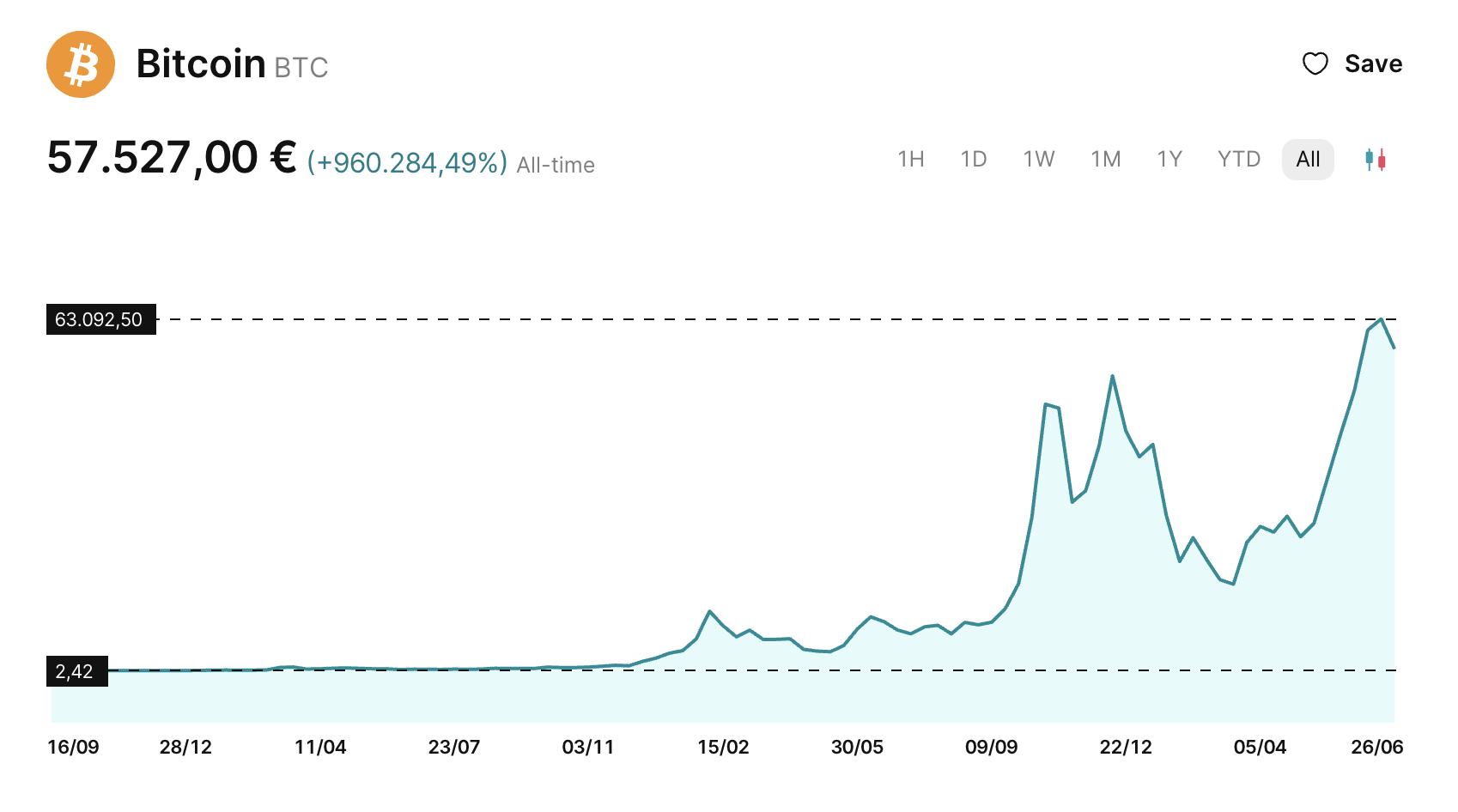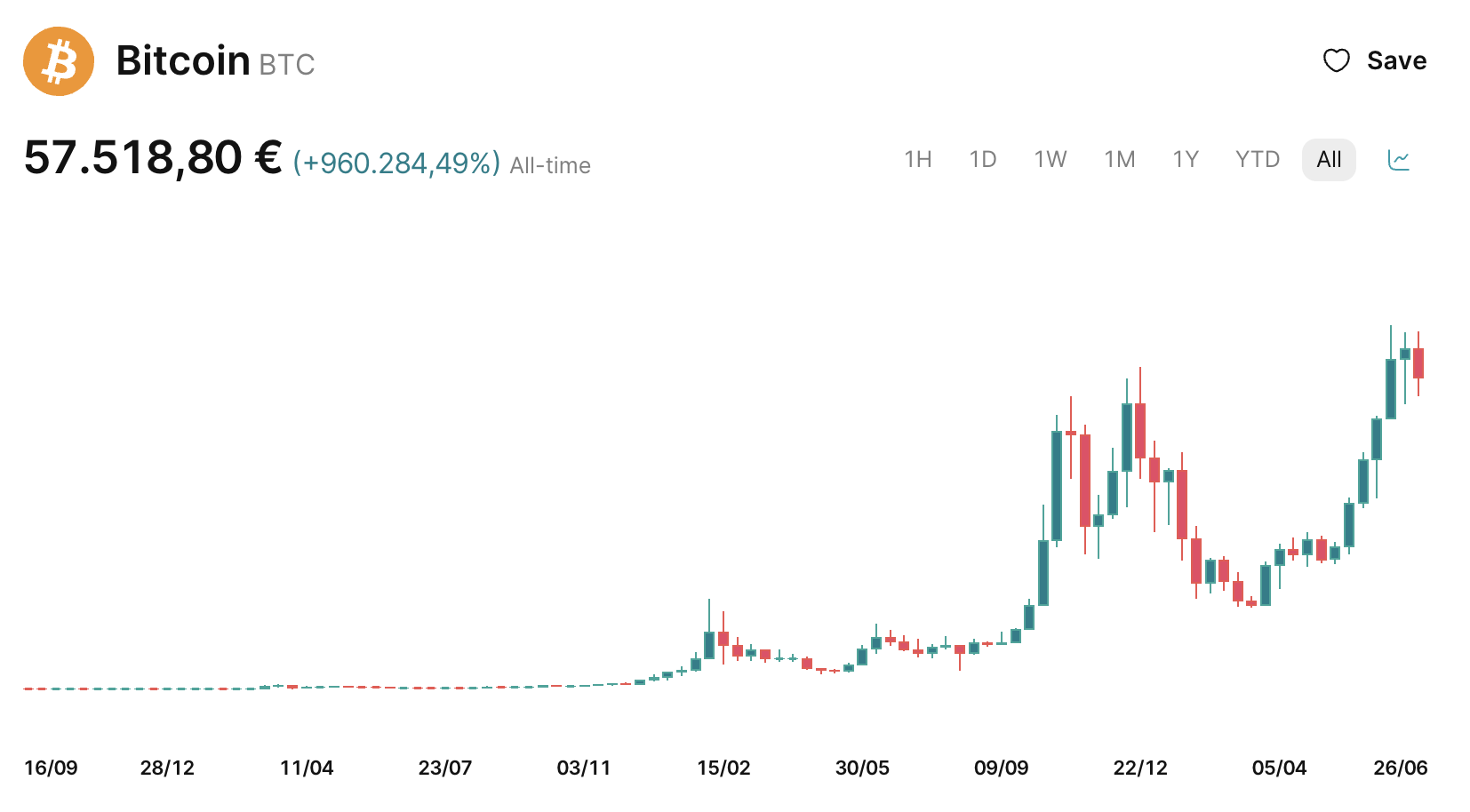What is Bitcoin?

Bitcoin (BTC) is without a doubt the most popular cryptocurrency and a pioneer in the space so it’s only fair that we dedicate an article to exploring the ins and outs of BTC.
Key Takeaways
- Bitcoin (BTC) is the first successful decentralized cryptocurrency. It uses peer-to-peer technology to operate without the need for a central authority behind it.
- Bitcoin’s supply is limited to 21 million coins.
- Bitcoin was created by an unknown person or group of people using the pseudonym Satoshi Nakamoto.
- Bitcoin is used for several purposes. Some people use it for everyday transactions, while others prefer to use BTC as a store of value, making it an alternative to gold. Others simply invest, trade, and speculate using the cryptocurrency.
- The current Bitcoin price EUR is...
What is Bitcoin?
Let’s begin with answering one of the most common questions, what is Bitcoin?
Bitcoin was created by an unknown person or group of people using the pseudonym Satoshi Nakamoto. BTC’s technology was outlined in a 2008 whitepaper and the cryptocurrency was initially released in January 2009. Bitcoin is the first successful decentralized cryptocurrency. Decentralized meaning that no single institution or government controls it. It uses peer-to-peer technology to operate without the need for a central authority behind it. But how exactly does it work?
How Does Bitcoin Work?
Here’s a breakdown of how Bitcoin works:
Blockchain Technology
Bitcoin transactions are recorded on a public ledger called the blockchain. The blockchain is a chronological chain of blocks, where each block contains a list of transactions. The blockchain is maintained by a network of nodes (computers) that validate and relay transactions.
Decentralization
Bitcoin is decentralized, meaning no single entity controls the network. Instead, it is maintained by a distributed network of nodes. This ensures that no central authority can manipulate the currency or transactions.
Transactions
When someone wants to send bitcoins, they create a transaction, which is a message that specifies the amount to be sent and the recipient’s Bitcoin address. This transaction is broadcast to the network and picked up by nodes.
Mining
Transactions are grouped together into blocks by miners. Miners are nodes that validate transactions and secure the network by solving complex mathematical problems, a process called proof-of-work. The first miner to solve the problem gets to add the block to the blockchain and is rewarded with newly created bitcoins and transaction fees.
Proof-of-Work
The proof-of-work mechanism ensures the security and integrity of the blockchain. It requires miners to perform computationally intensive tasks, making it difficult for any single entity to control the network. The difficulty of these tasks adjusts over time to ensure a steady rate of block creation.
Ownership and Wallets
Bitcoin ownership is defined by private and public keys. A wallet contains a user’s private keys, which are used to sign transactions and prove ownership of bitcoins. The public key, or Bitcoin address, is used to receive bitcoins. Only the holder of the private key can spend the bitcoins associated with a given address.
Security and Anonymity
Bitcoin transactions are pseudonymous; while the transactions themselves are public, the identities of the participants are not directly tied to the Bitcoin addresses. However, the transparency of the blockchain allows for analysis, which can sometimes lead to the identification of users.
Supply Cap
Bitcoin has a capped supply of 21 million coins. This scarcity is designed to create deflationary pressure, making Bitcoin a store of value similar to gold. The reward for mining new blocks is halved approximately every four years, reducing the rate at which new bitcoins are created.
The short version
Bitcoin works through a combination of blockchain technology, decentralization, mining, and cryptographic security. Transactions are verified by a network of nodes, grouped into blocks, and added to a public ledger. Miners secure the network and are incentivized through rewards, while ownership of bitcoins is managed through cryptographic keys. This system allows Bitcoin to function as a secure and decentralized digital currency.
The History of Bitcoin
Bitcoin’s journey began with the publication of the Bitcoin whitepaper by Satoshi Nakamoto in 2008, which laid out the principles of a peer-to-peer electronic cash system. The first block of the Bitcoin blockchain, known as the Genesis Block, was mined in January 2009. Since then, Bitcoin has experienced tremendous growth, overcoming numerous challenges and gaining widespread acceptance.
The Significance of Decentralization
One of Bitcoin's notable features is its decentralization. Unlike traditional currencies issued by central banks, Bitcoin is governed by a decentralized network of computers. This decentralization offers several advantages:
-
Resilience to Censorship: Transactions cannot be easily censored or blocked by a central authority, providing financial freedom to users.
-
Security: The decentralized nature of the blockchain makes it extremely difficult for any single entity to manipulate the network, enhancing security.
-
Transparency: Every transaction is recorded on the blockchain, allowing anyone to verify and trace the movement of Bitcoins.
Bitcoin Price Dynamics
The Bitcoin price is known for its volatility, which can be attributed to some of the factors below:
-
Supply and Demand: The economic principle of supply and demand significantly affects Bitcoin's price. As the demand for Bitcoin increases, the price tends to rise, and vice versa.
-
Macroeconomic Trends: Broader economic trends, such as inflation, currency devaluation, and economic uncertainty, can influence Bitcoin's price. During times of economic instability, Bitcoin is often seen as a safe-haven asset.
-
Market Liquidity: The liquidity of Bitcoin markets affects price stability. Higher liquidity typically leads to more stable prices, while lower liquidity can result in greater volatility.
-
Regulatory News: Announcements from governments and regulatory bodies can significantly impact Bitcoin's price. Positive news, such as the approval of Bitcoin ETFs or favorable regulatory changes, can drive prices up, while negative news, such as bans or restrictions, can lead to price declines.
-
Market Sentiment: Investor sentiment plays a crucial role in Bitcoin's price dynamics. Positive sentiment, driven by news of adoption and technological advancements, can lead to price increases, while negative sentiment can result in sell-offs.
-
Technological Developments: Innovations and upgrades within the Bitcoin ecosystem, such as improvements to scalability and transaction speed, can positively impact investor confidence and drive price increases.
-
Bitcoin Halving: One of the most significant events affecting Bitcoin's price is halving. This event reduces the reward for mining new blocks by half, effectively reducing the rate at which new Bitcoins are created.
What is Bitcoin Price History
Now that we’ve explored the factors that impact the price of Bitcoin, let’s dive into the history of Bitcoin’s price. Starting with some Bitcoin price charts from our platform. The first is a regular Bitcoin all-time price chart.

The second is a Bitcoin all-time price candlestick chart. Both can be found and the timeframe can be adjusted on our platform.

2009–2015
Bitcoin was introduced in 2009 with a price of zero. By October 2010, its price rose from $0.10 to $0.20 and reached $0.30 by year-end. In 2011, Bitcoin's price surpassed $1, peaking at $29.60 in June before dropping to about $5 by the end of the year. 2012 saw modest gains, but in 2013, Bitcoin's price surged, starting at $13, crossing $100 by April, $200 by October, and ending the year at $732 after reaching over $1,000 in November.
2016–2020
Bitcoin's price slowly increased through 2016, ending above $900. In 2017, it hovered around $1,000 before skyrocketing to $19,188 in December. This spike attracted mainstream investors and attention from various sectors. In 2018 and 2019, Bitcoin's price fluctuated with bursts of activity, surpassing $10,000 in June 2019 but closing the year at $6,612. In 2020, amid the COVID-19 pandemic, Bitcoin's price surged from $7,161 in January to $28,993 by year-end, a 416% increase.
2021–2023
In January 2021, Bitcoin's price exceeded $40,000, and by mid-April, it reached over $60,000, peaking at $64,895. Prices fell to $30,829 by July but rebounded to $52,956 in September. By November, it hit an all-time high of $69,000 before dropping to $46,211 in December. In 2022, Bitcoin's price declined gradually, closing at $47,459 in March and falling below $20,000 by year-end. In 2023, Bitcoin rose consistently, starting at $16,530 and ending the year at $42,258, mirroring stock market trends.
2024
In January 2024, the SEC's review of Bitcoin Spot ETFs led to increased holdings by some brokerages and significant outflows from others, like Grayscale's Bitcoin Trust. Market stability returned by March as investors had more options. Bitcoin's price climbed, surpassing $60,000 in early March and reaching record highs of $$73,780.07.
So, now that we’ve looked at some of the historical Bitcoin price trends, let’s look at how you can buy Bitcoin.
How to Buy Bitcoin
Step 1: Research and Choose a Reliable Exchange
Before entering the world of Bitcoin and other cryptocurrencies, thoroughly research and choose a reliable exchange. Opt for platforms with a user-friendly interface, strong security, and a broad range of cryptocurrencies. With Finst you can trade over 110 cryptocurrencies in EUR, with maximum safety and transparency.
It is also important to consider the fees that you incur while trading crypto. Using Finst, you will encounter the lowest trading fees in the Netherlands without any hidden costs. A flat fee of 0,15% per trade. That’s it.
You save an average of 83% on your trading fees. But don’t take our word for it, check out the comparison chart on our fees page.
Step 2: Create an Account
Once you've chosen an exchange, the next step is to create an account. You can open an account online with Finst without any costs. Opening an account only takes 5 minutes, click here to get started.
Step 3: Deposit Funds
After successfully creating your account, you can make your first EUR deposit. Finst currently supports instant payment methods such as iDEAL, Bancontact, and SEPA bank transfers.
Simply deposit funds to your account by clicking on the “Deposit/Withdrawal” button located on the trading platform and follow the instructions. You can also Deposit funds via bank transfer in EUR with the unique payment description in your account. At Finst depositing and withdrawing funds is always free without any minimum amount.
Step 4: Buy Bitcoin
With funds in your account, it's time to buy Bitcoin or of course any other cryptocurrency you’d like to invest in. Use the search function on the platform to find Bitcoin. If you're new to the world of crypto, consider starting with well-known cryptocurrencies like Bitcoin (BTC) or Ethereum (ETH).
Step 5: Place an Order
Decide on the amount of EUR you want to invest or the quantity of Bitcoin you want to buy and place an order on the platform. You’re all set. Congratulations on your trade!
To see a tutorial on how to buy crypto with Finst, click on the video below.
Storing your Bitcoin
Now that you’ve successfully bought Bitcoin, you might be thinking of ways to best store your BTC. You can keep your Bitcoin in your Finst account. This is protected with some of the most advanced security technology. For more information on how we keep your assets safe check out our dedicated security article.
You may also choose to withdraw your Bitcoin to a hardware wallet like Ledger. A hardware wallet is a physical device specifically designed to store the private keys associated with your cryptocurrencies securely. Withdrawing your BTC can be easily done in the Finst app by navigating to the asset you’d like to withdraw and by tapping on the “Withdraw” button. Follow the steps to withdraw your crypto.
Now that we’ve looked at how you can buy and store your Bitcoin, it’s worth exploring some more factors that have impacted the price of BTC in recent times. If you read crypto news from time to time, you’ve probably come across the term Bitcoin ETF recently. But what exactly is a Bitcoin ETF and how does it affect the price of BTC?
What is a Bitcoin ETF?
A Bitcoin ETF (Exchange-Traded Fund) is a financial product that tracks the price of Bitcoin and is traded on traditional stock exchanges. It allows investors to gain exposure to Bitcoin without having to buy and store the actual cryptocurrency.
Impact on the Bitcoin Price
The introduction of Bitcoin ETFs has significantly influenced Bitcoin's price behavior. These ETFs draw institutional investors who previously avoided the cryptocurrency market due to regulatory and security issues. The influx of institutional capital enhances market liquidity and stability, ultimately reducing long-term volatility. Additionally, the approval of Bitcoin ETFs acts as a regulatory endorsement, affirming Bitcoin as a legitimate investment, which boosts investor confidence and increases demand for the digital currency.
A key effect of Bitcoin ETFs is their role in improving market liquidity and mitigating Bitcoin's well-known volatility. By attracting substantial capital from institutional and traditional investors, Bitcoin ETFs facilitate smoother price movements. Institutional participation is likely to reduce volatility due to the strategic and long-term nature of their investments.
Another recent event worth mentioning is the Bitcoin halving. In the past, this has had an impact on the price of Bitcoin. We wrote a dedicated article about the Bitcoin halving which you can check out here. Nonetheless, let’s have a brief recap.
What is the Bitcoin halving?
The Bitcoin Halving is when Bitcoin's mining reward is split in half. The blockchain network requires approximately four years to unlock an additional 210,000 blocks, adhering to the standard established by its creators to steadily diminish the rate at which the cryptocurrency is introduced.
This year’s Bitcoin halving occurred on the 19th of April. At this point, the mining rewards per block were reduced to 3.125 BTC.
The halving event directly impacts Bitcoin's supply. With fewer bitcoins being mined, the growth rate of the supply decreases. However, the market response heavily depends on demand dynamics. If demand remains steady or rises, the reduced supply could lead to an increase in Bitcoin's price due to its heightened scarcity and perceived value.
Conclusion
Bitcoin represents a revolutionary step in the evolution of money and finance. As a decentralized digital currency, it offers an alternative to traditional financial systems by enabling peer-to-peer transactions without the need for intermediaries like banks. Bitcoin's underlying blockchain technology ensures transparency, security, and immutability, which are critical features in a digital economy. Despite its volatility and the regulatory challenges it faces, Bitcoin's growing acceptance and adoption reflect its potential to transform how we perceive and use money.
Bitcoin's journey from a niche concept to a mainstream financial instrument highlights its significance in the global economy. Its ability to facilitate borderless transactions opens up new possibilities for international trade and remittances, making financial services more accessible to unbanked populations around the world. Additionally, Bitcoin has inspired the creation of numerous other cryptocurrencies and blockchain-based technologies, fostering innovation in various sectors beyond finance, including supply chain management, healthcare, and voting systems.
However, Bitcoin is not without its challenges. Its price volatility can be a barrier to its use as a stable medium of exchange, and the regulatory environment surrounding Bitcoin continues to evolve, with governments and financial institutions grappling with how to integrate this new asset class into existing frameworks.
Despite these challenges, the potential benefits of Bitcoin are undeniable. As more individuals, businesses, and institutions recognize and adopt Bitcoin, its influence is likely to grow, prompting further advancements in technology and regulatory policies. The continued development and maturation of the Bitcoin ecosystem could lead to a more inclusive and efficient global financial system.
